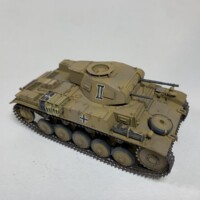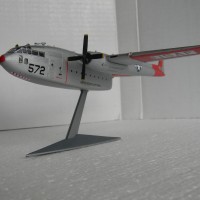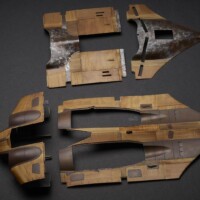Bud Anderson's P-51B "Old Crow"
The Airplane:
After my friend Brigadier General Clarence E. “Bud” Anderson passed away on 17 May 2024, and having received review copies of the new Bullseye decals for 357th Fighter Group P-51Bs, I decided to make this model of Bud's famous “Old Crow” P-51B-10 in his memory.
Bud Anderson was born in Oakland California on January 13, 1922, and spent his early years on a rural farm near Newcastle California, where he attended Placer Union High School, Sacramento Jr College and George Washington University. He learned to fly at 19, gaining his private pilot's license in 1941 through the Civilian Pilot Training Program while attending college. In January 1942 he entered the US Army Aviation Cadet Program, where he received his wings and commission in September 1942.
He joined the recently-activated 357th Fighter Group at Hamilton Field, California and was assigned to the 363rd Fighter Squadron.
After training was completed, the 357th was assigned to the Ninth Air Force in England, arriving in November 1943. They were the third Ninth Air Force fighter group to be equipped with the new P-51B Mustang. After a high level argument between Eighth and Ninth Air Force over the use of the P-51B, General Eisenhower authorized the 357th's transfer to VIII Fightrer Command, with the P-47-equipped 358th Fighter Group transferred Ninth Air Force in return. The 357th became operational in February 1944 in time to participate in Big Week.
Bud flew two combat tours with the 357th, flying 116 combat mission in 480 hours, destroying 16.25 enemy aircraft in aerial combat and one on the ground. Bud was the highest scoring ace in the 363rd Fighter Squadron.
Bud's airplanes were all named “Old Crow,” for the cheapest bourbon whiskey available at the time, beginning with the P-39Q he flew during training in the US. The first P-51B-1, s/n 43-6723, was lost on 21 February 1944 with 2nd Lt. Al Boyle, who became a POW. Bud's second P-51B, 43-12315, was brought into the 357th by former RAF exchange pilot Lt Melvin Kehrer, who flew it in the 362nd FS; after Kehrer was lost on his fourth mission in P-51B 43-6625, on 25 Feb 1944, Bud was assigned the airplane, which became his second P-51B “Old Crow.” This P-51B was lost on 22 March 1944 with Lt Carter Jones, who became a POW.
Bud's third Mustang, P-51B, 43-24823, lasted the rest of his first combat tour. This airplane arrived in the group in May 1944 unpainted, and was given an overall camouflage scheme of RAF Dark Green upper surfaces and Sea Grey Medium lower surfaces, and was fitted with a Malcolm canopy. Bud shot down 12.25 German aircraft in this airplane, which was given to 1st Lt Bill Overstreet who repainted it as “Berlin Express” after Bud went home on end-of-tour leave. It eventually was assigned as a trainer at the 357th's Clobber College for replacement pilots and survived the war.
The Kit:
Eduard's “Overtrees” kits have the plastic of the standard kit, without the photoetch detail set or decals. I used the new Eduard “Look-plus” instrument panel and photoetch seatbelts, and used Bullseye Decals new “Yoxford Boys #6" sheet, 48-032 for the markings. Scott Brown's decal series for 357th Fighter Group P-51s, was extensively researched by Scott, who knew most of the group's pilots over the past 30 years. The decals are printed by Cartograf from designes by Scott and Jennings Heilig, and are top quality. These sheets are sold exclusively by a model kit distributor whose name doesn't get mentioned at Modeling Madness, due to the owner's inability to separate his perrsonal politics from his business dealings.
Construction:
The kit was assembled following the instructions, with deviations from the instructions since I knew the areas of “fiddly” to deal with. The best way to assemble the cockpit, which is the major fiddly area, is to slice off the guides on the fuselage sides, assemble the cockpit on the floorboard, then attach the side detail panels to the cockpit assembly in order to get them properly aligned, then glue this entire assembly into the fuselage. Everything came together very easily with no misalignment on either fuselage half. All else was done followeing the instructions with no difficulty.
Painting:
I decided to do the model with the full D-Day stripes. I first airbushed a thin coat of Tamiya Flat White XF-2, then masked these off with Tamiya tape so they were not neat and straight, as show in photos of the original airplane. I then airbrushed XF-1 Flat Black, and masked those off. After preshading panel lines with XF-1, I painted the upper surfaces with XF-81 RAF Dark Green and the lower surfaces with XF-83 RAF Sea Grey Medium.
I unmasked the stripes and brush painted the white stripes with thinned XF-2 Flat white, to deepen the color and leave it “distressed” with brush strokes, for a realistic look.
Decals:
The decals went on without problem under a coat of Micro-Sol. The decals are thin, and will get wrecked if you use a stronger setting solution.
Final Assembly:
I used Eduard Brassin wheels, painted with “white sidewalls”. The Malcolm hood was attached in the open position.
Overall:
The Eduard P-51B kit is excellent, whether you use a Profipack kit or the cheaper Overtrees. I have a model of Bud's P-51D and long wanted to have his P-51B. Recommended for all modelers other than beginners.















Nice build Tom. Bud Anderson was definitely a class act.
Super job, Tom! A great tribute to your friend!
A wonderful build to remember your friend, Tom @tcinla
Those invasion stripes do look very nice this way.
Gorgeous build, Tom @tcinla. The faded white of the invasion stripes looks very good! I always liked the elegant shape of the P51B a lot.
I've always thought that the overtrees concept is a brilliant idea and you've taken full advantage of it. A very nice commemoration of a friend.
@tcinla - Fantastic write up and build as always Tom. My ex-wife's Dad still drinks Old Crow. LOL. I really like how you painted the white stripes to look a bit rough. It definitely feels like they were field painted.
Well done, Tom
Nice write-up, Tom.
Great work Mr. Cleaver, as always. Gen. Anderson's -B model P-51 has always been o e of my favorites, right up there with Ding Hao, Shanghai LA, Short Fuse Sally, and the Berlin Express. I never knew that Berlin Express was originally o e of the Old Crows.
It's great to see someone actually paint the D-Day strips inperfec as they shood be. Most people don't realize that the ground were painting these on thousands of aircraft at the last minute, and perfection wasn't a priority.
Beautiful job. I really need to pick up a couple of these Eduard P-51Bs.
Superb! I really love the "distressed"D-Day stripes.
Outstanding work.
A beautiful rendition of one of the most iconic Mustangs of the war. Well done!
Another excellent build, Tom.
Terrific, Tom @tcinla. (a backwards pun?). Liked it so much I have this kit on pre-order.
Excellent article and build.
You really nailed this one, Tom. The color demarcations between the green and the gray look spot on. Free hand or raised masks? Finally, how did you mask the thin green areas around the codes on the invasion stripes?
All freehand @j-healy. Fortunately, Scott Brown has come to the rescue by printing squadron codes with and without the thin green demarcation, so you can do the model before or after D-Day without problem.
A fantastic build Tom and a very fitting tribute.
Great build and very interesting information about all Mustangs.